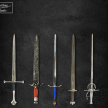
Introduction:
In the vast corridors of history, resonating with the echoes of battles and the blossoming of chivalry, the unmistakable clank of steel and the radiant gleam of suits of armor encapsulates the very essence of medieval warfare. This distinctive exploration takes us on a captivating journey through the evolution, artistic intricacies, and profound cultural impact of these emblematic protective ensembles. From the nascent innovations of mail armor to the apex of Gothic plate craftsmanship, and ultimately to the fading glory of the knight confronted by firearms, the narrative of medieval suits of armor unfolds as a compelling odyssey across the ages.
I. The Genesis: Mail Armor and the Emergence of the Knight
The roots of medieval armor delve into the early medieval period, coinciding with the emergence of the knight as a distinct warrior class. Chainmail, a rudimentary defense comprising interlinked metal rings, provided a modest safeguard against the slashing and stabbing weapons of the era. As the medieval battlefield underwent transformations, so did the armor adorning its valiant warriors.
Eager to augment their protective gear, early knights initiated a transition from mail armor to more sophisticated plate armor. This marked the inception of the iconic suits of armor, laying the groundwork for the distinct silhouette that would come to symbolize the medieval knight.
II. Transition to Plate Armor: A Revolutionary Shield
The 13th century witnessed a groundbreaking leap in armor technology as knights began integrating plate components over their mail. This innovative approach furnished superior protection against increasingly formidable weaponry. Early forms of plate armor covered critical areas such as the chest, back, and limbs, delivering formidable defense while still permitting relative ease of movement.
Beyond its practical necessity, plate armor metamorphosed into a symbol of the evolving ideals of knighthood. The knight in shining armor, adorned in a radiant steel shell, became the living embodiment of martial prowess and chivalric virtue.
III. Artistry Meets Functionality: The Elegance of Gothic Plate Armor
The 14th century stands as the zenith of medieval armor craftsmanship with the advent of Gothic plate armor. This exquisite form of protection transcended mere functionality, elevating armor to the realm of art. Characterized by sleek lines, pointed ridges, and articulation facilitating increased mobility, Gothic plate armor became synonymous with both aesthetic beauty and martial strength.
Craftsmen infused these suits with intricate engravings and heraldic symbols, transforming them into expressions of individual identity and familial pride. The marriage of artistry and functionality reached its pinnacle, with Gothic plate armor not merely reflecting the physical protection it offered but also encapsulating the ideals of honor and nobility to which knights aspired.
IV. Renaissance Refinement: Maximizing Mobility in Full Harness
With the dawn of the Renaissance, armor underwent further refinements to meet the evolving demands of warfare. The development of "full harness" suits of armor marked a significant milestone, covering the entire body and featuring articulated joints that granted knights unprecedented freedom of movement.
In an era shadowed by the advent of gunpowder and evolving weaponry, armor adapted to withstand new threats. The Renaissance saw the integration of thicker plates to counter the growing power of firearms while still preserving the agility necessary for knights to engage in combat.
V. The Decline of the Knight: Armor Confronting Firearms
The late medieval period and the early modern era witnessed a decline in the use of traditional suits of armor, driven by the emergence of firearms. Firearms rendered the once-impervious armor vulnerable, fundamentally altering the dynamics of medieval warfare. Despite the changing role of the knight on the battlefield, suits of armor did not vanish entirely.
Armor adapted to the times, becoming more specialized. Heavier breastplates catered to the needs of cavalry, while lighter, more flexible armor suited infantry. Additionally, the concept of "tournament armor" emerged, designed more for display and jousting than for the rigors of the battlefield.
VI. Legacy and Resurgence: Armor in the Cultural Tapestry
While suits of armor may have ceased to be practical on the battlefield, their legacy endured within the collective consciousness. The image of the medieval knight, clad in shining steel, emerged as a potent symbol of chivalry, honor, and martial skill. This enduring fascination with knights and armor found rejuvenation in literature, art, and, later, film.
The 19th-century Romantic movement sparked a renewed interest in medieval history, contributing to the romanticized image of knights in shining armor. Today, the allure of medieval armor persists in popular culture, with countless movies, video games, and reenactments paying homage to the knights of old.
VII. Modern Reinterpretations: Armor as Contemporary Art and Symbol
In contemporary times, the spirit of medieval armor lives on through modern reinterpretations. Artists and craftsmen draw inspiration from historical designs, fashioning bespoke suits of armor that seamlessly blend tradition with innovation. These contemporary creations transcend mere functionality; they are veritable works of art, embodying the enduring fascination with the aesthetics and symbolism of medieval armor.
Conclusion:
The tale of medieval suits of armor unfolds as a mesmerizing narrative of innovation, artistry, and cultural resonance. From the modest beginnings of chainmail to the refined elegance of Gothic plate body armor, these ensembles not only shaped the identity of the medieval knight but also became enduring symbols of chivalry and honor. Although the decline of the knight in the face of firearms altered the course of history, the legacy of suits of armor perseveres, woven into the tapestry of human culture as an emblem of courage, nobility, and the indomitable spirit of the medieval warrior.
About the Creator
Owen J
Fascinating realm of medieval weapons from various regions, chronicling my quest to uncover their historical significance. I have made intriguing discoveries and encountered remarkable individuals who have regaled me with captivating tales.






Comments
There are no comments for this story
Be the first to respond and start the conversation.